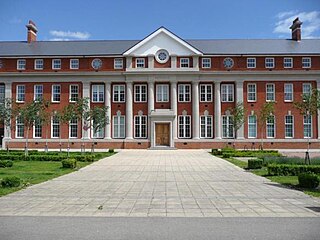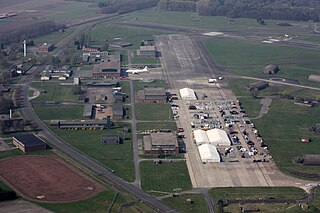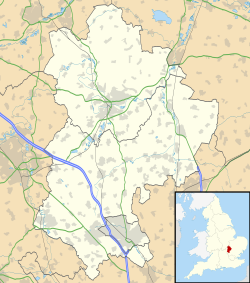
London Biggin Hill Airport is a minor commercial airport serving Biggin Hill in the London Borough of Bromley, located 12 NM south-southeast of Central London. It specialises in general aviation, handling a spectrum of traffic from private aviation to large business jets. It currently has no scheduled airline service, as flights using the airport are not regularly permitted to carry fare-paying passengers.

Royal Air Force Mona, or more simply RAF Mona, is a Royal Air Force station near Bodffordd on the island of Anglesey, Wales. It is primarily used as a relief landing ground for RAF Valley.

Royal Air Force Syerston, commonly known simply as RAF Syerston, is a Royal Air Force station in the parish of Flintham, near Newark, Nottinghamshire, England. Opened in 1940, it was used by the Royal Air Force (RAF) as a bomber base during the Second World War, operating Vickers Wellingtons, Avro Manchesters, and the Avro Lancaster heavy bombers. Post-war, it became home to Jet Provosts of the 2 Flying Training School. It is now home to the Royal Air Force Central Gliding School.

Royal Air Force West Malling or more simply RAF West Malling is a former Royal Air Force station located 1.6 miles (2.6 km) south of West Malling, Kent and 5.2 miles (8.4 km) west of Maidstone, Kent, England.

Cardington is a village and civil parish in the Borough of Bedford in Bedfordshire, England.

Hendon Aerodrome was an aerodrome in London, England, that was an important centre for aviation from 1908 to 1968.
Royal Air Force Bircham Newton or more simply RAF Bircham Newton is a former Royal Air Force station located 2.1 miles (3.4 km) south east of Docking, Norfolk and 13.4 miles (21.6 km) north east of King's Lynn, Norfolk, England.

Eastcotts is an electoral ward within the Borough of Bedford, in the ceremonial county of Bedfordshire, England. It was formerly also a civil parish until its abolition on 1 April 2019, when Cotton End and Shortstown parishes were established.

Shortstown is a village and civil parish on the outskirts of Bedford, on a ridge above the River Great Ouse, originally called Tinkers Hill. The ridge overlooks Harrowden to the north and Cotton End to the south. The village name is taken from Short Brothers. The Admiralty established an airship works for the company in 1916. The company pulled out of airship work just three years later, but the name Shortstown stuck.

Royal Air Force Chilbolton or RAF Chilbolton is a former Royal Air Force station in Hampshire, England. The airfield was located in Chilbolton approximately 4 miles (6.4 km) south-southeast of Andover, about 62 miles (100 km) southwest of London.

MOD West Freugh is located in Wigtownshire, 5 miles (8 km) south east of Stranraer, Dumfries and Galloway, Scotland, and is operated by defence contractor QinetiQ, on behalf of the Ministry of Defence.

Royal Air Force Bottesford or more simply RAF Bottesford is a former Royal Air Force station located on the Leicestershire-Lincolnshire county border, 6.8 miles (10.9 km) north west of Grantham, Lincolnshire and 7.6 miles (12.2 km) south of Newark-on-Trent, Nottinghamshire and about 107 miles (172 km) north-northwest of London, England.
Royal Air Force Grangemouth or more simply RAF Grangemouth is a former Royal Air Force station located 3 mi (4.8 km) north east of Falkirk, Stirlingshire, Scotland.

Royal Air Force Ahlhorn or more simply RAF Ahlhorn, is a former Royal Air Force station located 1 mile (1.6 km) south east of the centre of Ahlhorn, Lower Saxony and 11 miles (18 km) north of Vechta, Lower Saxony, Germany.

Royal Air Force Llandow, or more simply RAF Llandow, is a former Royal Air Force station situated near the village of Llandow, Vale of Glamorgan, South Wales, 15 miles (24 km) west of Cardiff.

Royal Air Force Cranage or more simply RAF Cranage is a former Royal Air Force Satellite station operated during the Second World War. It was located just to the North of Middlewich, Cheshire, England.
Royal Air Force Wymeswold, or more simply RAF Wymeswold, is a former Royal Air Force satellite station located 3.5 miles (5.6 km) north-east of Loughborough, Leicestershire, England. The airfield is situated between Hoton, Wymeswold and Burton on the Wolds, lying in the current district of Charnwood.

Royal Air Force Culmhead or more simply RAF Culmhead is a former Royal Air Force station, situated at Churchstanton on the Blackdown Hills in Somerset, England.

Royal Air Force Church Fenton or RAF Church Fenton is a former Royal Air Force (RAF) station located 4.3 miles (6.9 km) south-east of Tadcaster, North Yorkshire, England and 6.3 miles (10.1 km) north-west of Selby, North Yorkshire, near the village of Church Fenton.
Royal Air Force Bodorgan, or more simply RAF Bodorgan, is a former Royal Air Force satellite airfield located near to Bodorgan Hall on the Isle of Anglesey, Wales. The airfield was opened as RAF Aberffraw on 1 September 1940. Its named was changed to Bodorgan on 15 May 1941, and it was closed on 30 September 1945.


























